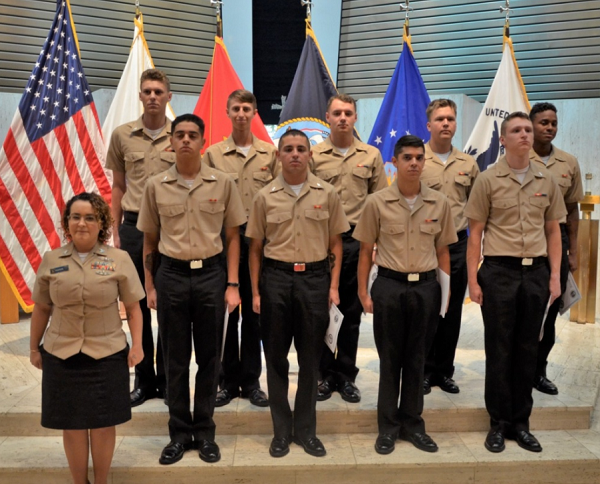Navy A School provides technical training for sailors based on their individual ratings.
Immediately following boot camp graduation, sailors will go to their Navy A School to receive instruction on job functions and duties.
You may be wondering what Navy A School is, where they are located, or what you can bring with you.
The guide below will provide information on the topics above and more.
Continue reading for details about all 23 Navy A School locations.
Related Article – Here’s What Happens After Navy Boot Camp
Table of Contents
What is Navy A School?
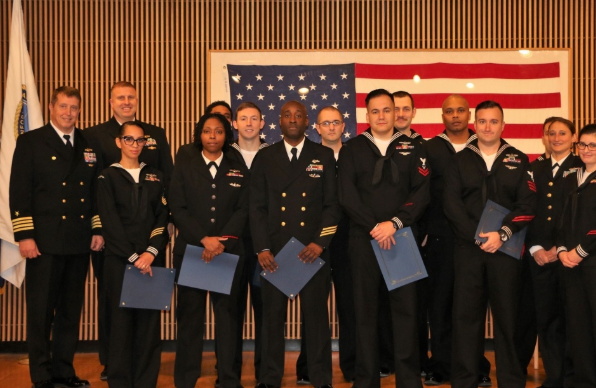
Navy A School is the first stage of technical training for your specific rating.
Individuals will attend Navy A School after they have completed boot camp.
The length and location of training depend on the specific rating.
Navy A School does not have as many restrictions as boot camp but does not allow as many freedoms as a sailor will have once they complete training.
As sailors gradually move through A School and complete different phases, their restrictions are slowly lifted and liberties are increased.
Navy A School will teach functions related to rating job duties, but also ensure that sailors meet satisfactory physical requirements, appearance requirements and academic standards.
In Navy A School, individuals will learn skills, complete physical training, complete watch standing, and complete daily routine requirements.
Where is Navy A School Conducted?
Navy A Schools can be found in various locations around the United States. See the states where Navy A Schools can be found below, along with the Navy Schools in those states.
California
Naval Base Point Loma
San Diego, California
https://cnrsw.cnic.navy.mil/Installations/NAVBASE-Point-Loma/
NB Point Loma is an administrative center for the Navy throughout the Southwestern United States. Navy recruits in the Minemen Rating train at this facility.
Naval Base San Diego
San Diego, California
https://cnrsw.cnic.navy.mil/Installations/NAVBASE-San-Diego
Surface Sonar Technicians attend A School at NB San Diego. The installation lies on San Diego Bay and is the homeport for the Pacific Fleet Surface Navy.
Naval Base Coronado
San Diego, California
https://cnrsw.cnic.navy.mil/Installations/NAVBASE-Coronado/
NA Coronado is located about 80 miles from San Diego and serves as a shore-based platform for Navy aircraft carriers and helicopters. It also hosts the Naval Special Warfare Training Center. This includes both schools for SEALs (BUD/S), and for Special Warfare Combatant Crewmembers (SWCC).
Defense Language School
Monterey, California
https://nps.edu/
Cryptological interpreters may find themselves attending A School at “The Presidio” in Monterey, California. USAG Presidio is the home of the Defense Language Institute Foreign Language Center (DLIFLC), where many US service members receive foreign language training once passing the DLAB exam.
Naval Construction Battalion Center Port Hueneme
Port Hueneme, California
https://www.netc.navy.mil/NCTCPH/
Port Hueneme serves as an interservice training partner for Navy and Air Force students in specialized construction skills. It is the West Coast home of the Seabees. The Naval Construction Training Center can be found in Port Hueneme, providing training for construction ratings.
Related Article – Defense Language Aptitude Battery (DLAB) Test Guide
Connecticut
Naval Submarine Base New London
Groton, Connecticut
https://cnrma.cnic.navy.mil/Installations/SUBASE-New-London/\
NSB New London is the primary East Coast Navy installation and its mission is to train professional submariners. It serves as the A school for electronics technicians who work with information, navigation, and communications equipment aboard submarines.
Florida
Naval Support Activity Panama City
Panama, Florida
https://cnrse.cnic.navy.mil/Installations/NSA-Panama-City/
NSA PC houses the Naval Surface Warfare Center and Navy Experimental Diving Unit. It provides several levels of training for Navy Divers after they qualify and complete the preparation program at Great Lakes.
Naval Air Station Pensacola
Pensacola, Florida
https://cnrse.cnic.navy.mil/Installations/NAS-Pensacola/
Aviation Schools Command provides training for enlisted aircrew for both the Navy and Marine Corps. Navy recruits in air traffic control, avionics, aviation fuels, and similar ratings attend A School at NAS Pensacola. The school provides training for Cryptologic Technicians and Information System Technicians (IT).
Naval Air Station and Naval Aviation Technical Training Center is in Pensacola as well and provides training for aviation-related ratings.
Illinois
Naval Station Great Lakes
Chicago, IL
https://cnrma.cnic.navy.mil/Installations/NAVSTA-Great-Lakes/
Naval Station Great Lakes is located on Lake Michigan, north of Chicago, and is the home of Navy boot camp. It was established in 1911 and currently serves as the US Navy’s largest training center. Navy A Schools for a broad range of ratings take place on its 1,600-acre facility, including mechanical, electrical, and electronics specialties.
Maryland
Fort George Meade
Fort Meade, Maryland
https://home.army.mil/meade/index.php
This Army Facility houses the Defense Information School and Defense Media activity. It serves as A School for Navy specialists in Mass Communications, including digital multimedia, videography, public affairs, and photojournalism.
Mississippi
Naval Construction Battalion Center Gulfport
Gulfport, Mississippi
https://cnrse.cnic.navy.mil/Installations/NCBC-Gulfport/
Home to the Atlantic Fleet Seabees, NCBC trains those in Navy builder ratings. This includes those that work with carpentry, masonry, concrete, or steelworkers.
Naval Air Station Meridian
Meridian, Mississippi
https://cnrse.cnic.navy.mil/Installations/NAS-Meridian/
NAS Meridian is a major Navy training center that focuses on aviation and technical fields. Aviation administrative, Logistics, and Personnel specialists also train at this installation.
The Center For Naval Aviation Technical Training Unit Keesler
Biloxi, Mississippi
https://www.netc.navy.mil/CNATTKeesler/
The Center For Naval Aviation Technical Training Unit Keesler is located on the Gulf Coast on the grounds of Keesler AFB. It serves as a training center for Sailors and Marines in the use and calibration of test equipment.
Missouri
Fort Leonard Wood
St Robert, Missouri
https://www.netc.navy.mil/CSFEFLW/
This Army training facility hosts the Navy A School for new equipment operators and engineering aides in pursuit of careers as construction specialists in the Seabees. They’ll work with various types of heavy equipment and learn construction project support skills.
Rhode Island
Naval Station Newport
Newport, Rhode Island
https://cnrma.cnic.navy.mil/Installations/NAVSTA-Newport/
NAS Newport is the home of the Naval War College and Naval Justice School. It primarily services officers and senior enlisted service members. However, it also serves as A School for sailors training to become Legalmen (similar to civilian paralegals).
South Carolina
Naval Weapons Station Charleston
Charleston, South Carolina
https://www.jbcharleston.jb.mil/About-Us/Facilities/
Joint Base Charleston hosts over 60 DoD agencies, with a total force of over 90,000 service members and civilians. It is the center of the Navy’s Nuclear Power training program. Electronic, electrical, and machinist mates in the Nuclear Power field are all trained on the South Carolina installation.
Naval Chaplaincy School & Center at Fort Jackson, SC,
Columbia, South Carolina
https://home.army.mil/jackson/index.php/about/Garrison
Fort Jackson hosts training for the Religious Program Specialist Navy ratings. The Armed Forces Chaplaincy center serves as a hub for training Chaplains and support staff for all branches of the Armed Forces.
South Carolina also hosts the Naval Chaplaincy School and Center at Fort Jackson.
Texas
Sheppard Air Force Base
Wichita Falls, Texas
https://www.netc.navy.mil/Commands/Center-for-Seabees-and-Facilities-Engineering/Sheppard-AFB
The Center for Seabees and Facilities Engineering Detachment at Sheppard AFB is an interservice training partner for Navy, Air Force, and Army construction management crews. Electricians and Utilities specialists attend A School at Sheppard.
Naval Technical Training Center Lackland
San Antonio, Texas
https://www.netc.navy.mil/NTTCLackland/
The Naval Technical Training Center at Lackland AFB serves as A School for the Navy’s law enforcement career field. It also trains military working dogs and focuses on anti-terrorism training
Medical Education and Training Campus at Joint Base San Antonio-Fort Sam Houston
San Antonio, Texas
https://www.metc.mil/
METC is a Department of Defense training facility in Texas that provides enlisted health workers. It was established in 2010 to consolidate these key programs across the Navy, Air Force, and Navy.
Virginia
Naval Air Station Oceana
Virginia Beach, VA
https://cnrma.cnic.navy.mil/Installations/NAS-Oceana/
Naval Air Station Oceana hosts the A School for Navy Intelligence Specialist ratings. The Navy and Marine Corps Intelligence Training Center provides over 200 different courses to over 17,000 Sailors and Marines every year. Training is managed through the Dam Neck Annex at NAS Oceana
USAG Fort Lee
Fort Lee, Virginia
https://quartermaster.army.mil/jccoe/navy/jccoe_navy.html
Navy Culinary Specialists learn their skills at the Naval Technical Training Center Det, at Fort Lee. Over 1,100 Sailors train there yearly and receive basic food preparation skills. This center also provides basic culinary training for the Army and Marine Corps, as well as advanced skills training available to Air Force and Coast Guard cooks.
Joint Expeditionary Base Little Creek-Fort Story
Virginia Beach, Virginia
https://cnrma.cnic.navy.mil/jeb_little_creek_fort_story/
This facility combines the Little Creek Navy base and the Army’s Fort Story. Navy musicians attend A School at this historic site before being assigned to Navy Band in D.C. or the Naval Academy Band in Annapolis.
Complete list of A Schools and Programs
A School locations and the ratings that receive training at these locations can be found below. You will also find details on the training length and summary.
A Schools at Naval Base Point Loma, CA
Minemen (MN)
Length: 19 Weeks
Summary: Future Minemen will learn the skills necessary to locate and neutralize mines.
A Schools at Naval Base San Diego, CA
Sonar Technician, Surface (STG)
Length: 10 Weeks
Summary: Sonar Technician, Surface will learn basic operator and analyst skills. They will also learn sonar fundamentals.
A Schools at Naval Base Coronado, CA
Special Warfare Combatant-Craft Crewman (SWCC)
Length: 22 Weeks
Summary: Special Warfare Boat Operators will actually attend 3 schools, all at the same location. They include Special Warfare Combatant-craft Crewman Indoc. (SWCC) – 2 weeks; Basic Crewmember Training (BCT) – 5 weeks; and Crewman Qualification Training (CQT) – 15 Weeks. SBs are trained to support and conduct special operations and work primarily with the SEALs.
Special Warfare Operator (SO)
Length: 50 Weeks
Summary: Special Warfare Operators (SO), or SEALS, will attend 3 primary schools in Coronado. They include BUD/S – 31-35 weeks, Static Line / Free Fall Parachutist Training – 4 weeks, and SEAL Qualification Training (SQT) – 19 weeks. Training is demanding, both physically and mentally, and only a select few make it through.
A Schools at the Defense Language School, CA
Cryptologic Technician, Interpretive (CTI)
Length: 27-64 Weeks
Summary: Training at the Defense Language Institute includes extensive foreign language instruction. Length of time spent at school is dependent on the language selected to learn.
A Schools at Naval Construction Battalion Center Port Hueneme, CA
Construction Mechanic (CM)
Length: 16 Weeks
Summary: Individuals will learn basic construction skills and theories in addition to basic combat skills.
A Schools at Naval Submarine Base New London, CT
Information Systems Technician Submarines (ITS)
Length: 24 Weeks
Summary: Information Systems Technicians learn various software and hardware fundamentals. Types of software they will learn include Microsoft, Cisco, Oracle, and ADP.
Electronic Technician Navigation/Communication Submarines (ETV)
Length: 8 Weeks
Summary: Future Electronic Technician Navigation/Communication personnel will learn basic computer, electronics, and electricity skills through group assignments and applications.
Fire Control Technician (FT)
Length: 18 Weeks
Summary: Fire Control Technicians will learn the skills necessary to support operation and basic maintenance functions related to submarine weapon control systems. After A School, you may be assigned to a C School for advanced classes in specialized equipment.
Missile Technician, Submarines (MT)
Length: 7 Weeks
Summary: Future Missile Technicians will learn basic electronics and electricity in addition to learning digital theory. Advanced Training after A School takes place at King’s Bay, Georgia.
Machinist’s Mate Auxiliary (MMA)
Length: 9 Weeks
Summary: Through group instruction and practical application, Machinist’s Mate, Submarines will learn basic technical knowledge and skills related to the rating.
Torpedoman’s Mate (TM)
Length: 9 Weeks
Summary: This course teaches Sailors how to test, store, secure, maintain, and launch a variety of ordnance on Navy submarines.
Sonar Technician, Submarine (STS)
Length: 9 Weeks
Summary: This course will prepare individuals for underwater surveillance and science data collection specialties. It teaches basic electricity, electronics, and computer knowledge.
A Schools at Naval Support Activity Panama, FL
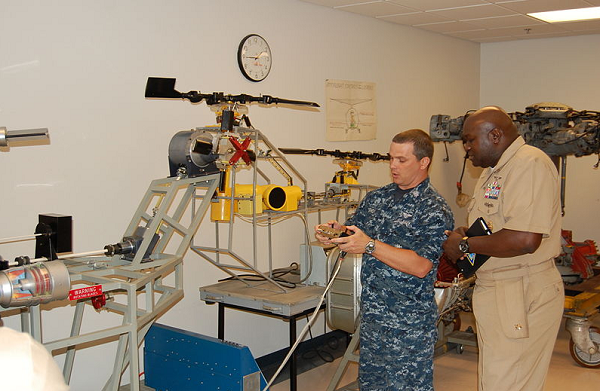
Navy Diver (ND)
Length: 15 Weeks
Summary: Future Navy divers will learn various underwater skills including welding, demolition, repair and the use of hydraulic tools. They will also learn Decompression Chamber operations. While Navy Divers take preparation training at Great Lakes, dive training takes place in Panama, FL.
A Schools at Naval Air Station Pensacola, FL
Air Traffic Controller (AC)
Length: 15 Weeks
Summary: Air Traffic Controllers will learn the fundamentals related to radio communication, Air Traffic Control, and radar.
Aircrewman Mechanical (AWF)
Length: 11 Weeks
Summary: Aircrewman Mechanical will learn skills related to aircraft balance calculations, aircraft maintenance and other skills of their specialized rating.
Aircrewman Helicopter – Sierra (AWS)
Length: 11 Weeks
Summary: Individuals in the Aircrewman Helicopter course will learn basic aviation theory. They will also learn any skills that are required for their specialized rating.
Aircrewman Operator (AWO)
Length: 13 Weeks
Summary: This course will teach Aircrewman Mechanical how to perform aircrew duties, handle ordnance and perform various operational missions. It will also teach basic aviation theory.
Aircrewman Tactical Helicopter – Romeo (AWR)
Length: 9 Weeks
Summary: Individuals will learn skills related to various Naval Special Warfare Missions. They will learn any skills that are required for this specialized rating.
Aircrewmen Avionics (AWV)
Length: 19 Weeks
Summary: Future Aircrew Avionics will learn the skills required for specialized rating job functions and basic aviation theory.
Information Systems Technician (ITS)
Length: 24 Weeks
Summary: Navy IT specialists learn the basics of networking and communications technologies at A School.
Aviation Electronics Technician (AT)
Length: 19 Weeks
Summary: Individuals will learn the skills of electricity. They will study basic theory, aviation electrical systems, and electronics theory.
Aviation Boatswain’s Mate, Aircraft Handling (ABH)
Length: 4 Weeks
Summary: This course will go over basic skills required for this rating including rescue and recovery and movements of aircraft.
Aviation Boatswain’s Mate, Fuels (ABF)
Length: 6 Weeks
Summary: Individuals will learn skills related to fueling and lubricating system maintenance, fuel quality surveillance, and any other skills required for the rating.
Aviation Boatswain’s Mate, Launch/Recovery Equipment (ABE)
Length: 5 Weeks
Summary: The course will teach individuals on skills related to operating catapult launch and arresting consoles. They will learn how to perform maintenance on hydraulic and steam catapults amount other aircraft components.
Aviation Electrician’s Mate (AE)
Length: 13 Weeks
Summary: Aviation Electrician’s Mate study basic theory and basic technical knowledge. They learn about aviation electrical systems and gain skills related to electricity.
Aviation Machinist’s Mate (AD)
Length: 4 Weeks
Summary: Aviation Machinist’s Mate will learn basic skills required for their rating including maintenance, repair, damage analysis and aviation basic theory. Four weeks of A School is followed by 2 weeks of specialized training based on your aircraft.
Aviation Ordnanceman (AO)
Length: 9 Weeks
Summary: This course teaches electronics troubleshooting, aviation basic theory, and how to properly handle ordnance.
Aviation Structural Mechanic (AM)
Length: 9 Weeks
Summary: Individuals in this program will complete the basic aviation structural mechanic course, basic aviation theory course and skills required for this specialized rating.
Aviation Structural Mechanic, Safety Equipment (AME)
Length: 9 Weeks
Summary: This course teaches maintenance of aircraft systems, inspection procedures, basic aviation structural maintenance and basic aviation theory.
Aviation Support Equipment Technician (AS)
Length: 17 Weeks
Summary: Aviation Support Equipment Technicians learn aviation basic theory and skills related to repair, maintenance, body work and operation.
Aircrew Survival Equipmentman (PR)
Length: 12 Weeks
Summary: Individuals in this course will learn basic skills that are required for Aircrew Survival Equipmentman job functions and aviation basic theory.
Cryptologic Technician, Collection (CTR)
Length: 18 Weeks
Summary: This course teaches computer fundamentals and teaches technicians equipment operations, signals theory and communications technology. Individuals will also learn satellite communications.
Cryptologic Technician, Maintenance (CTM)
Length: 13 Weeks
Summary: Cryptologic Technician, Maintenance will learn how troubleshooting techniques for various systems, how to operate software systems and networking concepts.
Cryptologic Technician, Networks (CTN)
Length: 23 Weeks
Summary: Individuals will learn communication theory and network configuration. They will learn troubleshooting theory and techniques.
Cryptologic Technician, Technical (CTT)
Length: 12 Weeks
Summary: Future Cryptologic Technician, Technical learn radar system operations, electronic intelligence analysis, reporting system methods, and radio-wave modulation principles.
Aviation Rescue Swimmer (AIRR)
Length: 23 Weeks
Summary: Aviation Rescue Swimmers dare perilous conditions to save both fellow service members and civilians. After A School in Pensacola, you’ll receive 2 weeks of survival, evasion, resistance, and escape training (SERE) at North Island, California, or Portsmouth, New Hampshire.
A Schools at Naval Station Great Lakes, IL
Boatswain’s Mate (BM)
Length: 5 Weeks
Summary: Future Boatswain’s Mate will learn basic safety and watch standing. They will learn how to complete underway replenishment, preventative maintenance, and deck seamanship.
Damage Controlman (DC)
Length: 10 Weeks
Summary: This course teaches fundamentals of ship stability, provides an introduction to firefighting systems and equipment, and trains individuals on drainage systems, emergency breathing devices, and equipment.
Electrician’s Mate (EM)
Length: 18 Weeks
Summary: Electrician’s Mates will learn basic mechanical theory, electrical math, AC/DC circuits, logic systems, and skills in electricity and electronics that are related to their rating.
Electronics Technician (ET)
Length: 30 Weeks
Summary: Future Electronics Technicians will learn the systems in the Communications Suite including SATCOM, and HF receiver/transmitter. They will study radar display and 2D Surface radar transmitters.
Engineman (EN)
Length: 14 Weeks
Summary: Individuals will learn the Maintenance Material Management System, how to operate hand tools, instruments and various systems in addition to learning basic watch standing and preventative maintenance.
Explosive Ordnance Disposal (EOD)
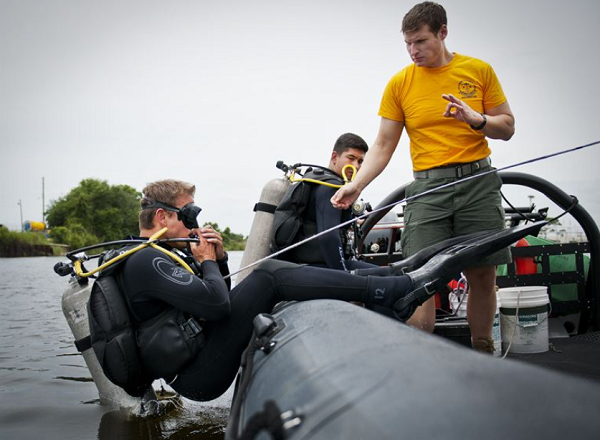
Length: 3 Weeks
Summary: Explosive Ordnance Disposal individuals will begin training at Great Lakes for water proficiency skills and physical conditioning. This is just the prep course. EOD training involves 51 more weeks at Panama for Diver training and Eglin AFB, FL, for advanced explosives training.
Fire Controlman (FC)
Length: 31 Weeks
Summary: Fire Controlmen learn basic electronics and electronic circuitry. They will study digital theory and learn troubleshooting techniques and how to run test equipment.
Gas Turbine Systems Technician, Mechanical (GSM)
Length: 15 Weeks
Summary: Gas System Mechanics will learn alignment of piping systems, lubricating systems, gas turbine engine theory, and how to work with electrical power, electro-mechanical and electro-hydraulic systems.
Gas Turbine Systems Technician, Electrical (GSE)
Length: 26 Weeks
Summary: Future Gas Turbine Systems Technicians, Electrical, will learn the Maintenance Material Management System, gas turbine engine theory and electrical math. They will learn how to work with AC/DC circuits, logic systems and other control systems.
Gunner’s Mate (GM)
Length: 15 Weeks
Summary: This course teaches basic technical knowledge of electricity and electronics. It also teaches Gunner’s Mates how to operate torpedo and launch systems.
Hull Maintenance Technician (HT)
Length: 18 Weeks
Summary: Hull Maintenance Technicians will learn blueprint reading, how to work with sheet metal, pipe fitting, and welding.
Interior Communications Electrician (IC)
Length: 21 Weeks
Summary: Individuals in this course will learn electrical math and basic schematics. They will learn how to work with AC/DC circuits, logic systems, and solid-state characteristics.
Machinery Repairman (MR)
Length: 18 Weeks
Summary: Machinery Repairman become familiar with machines, shop tools, equipment and methods. They will learn basic mechanical theory.
Machinist’s Mate (MM)
Length: 9 Weeks
Summary: Future Machinist’s Mate will learn operation of conventional marine steam propulsion systems. They will also learn safety precautions and how to work with various operating systems and equipment.
Operations Specialist (OS)
Length: 10 Weeks
Summary: Operational Specialists learn chart, anti-warfare, course-plotting, tracking, status board keeping, and radiotelephone coding.
Quartermaster (QM)
Length: 9 Weeks
Summary: Future Quartermasters will study navigation and Oceanography through group and classroom instruction.
A Schools at Fort George Meade, MD
Mass Communication Specialist (MC)
Length: 27 Weeks
Summary: Students will learn introductory skills in writing, photography, video, multimedia, problem-solving, public affairs, and communication.
A Schools at Naval Construction Battalion Center Gulfport, MS
Builder (BU)
Length: 10 Weeks
Summary: Future Builders will learn basic construction skills and theories. You’ll study basic carpentry, masonry, and millwork.
Steelworker (SW)
Length: 11 Weeks
Summary: Steelworkers learn basic construction skills and theories needed to complete the SW rating job functions.
A Schools at Naval Air Station Meridian, MS
Aviation Maintenance Administrationman (AZ)
Length: 8 Weeks
Summary: Future Aviation Maintenance Administrationman will learn logging, reporting and recording procedures. They will also learn organizational structure and aircraft operating practices.
Logistics Specialist (LS)
Length: 9 Weeks
Summary: This course teaches Logistics Specialists about automated data processing systems, how to keep financial records and accounting systems, and how to complete postal operations.
Personnel Specialist (PS)
Length: 5 Weeks
Summary: This course helps Personnel Specialists become familiar with forms and procedures related to personnel administration and job functions.
Retail Services Specialist (RS)
Length: 5 Weeks
Summary: Individuals will learn proper cash handling procedures, how to complete retail operations, and laundry operating procedures.
Yeoman (YN)
Length: 7 Weeks
Summary: Future Yeoman will become familiar with forms and procedures related to personnel administration through group instruction.
Yeoman Submarines (YNS)
Length: 7 Weeks
Summary: Future Yeoman Submarine individuals will learn the basic skills required for rating, including reporting and administrative functions, through group instruction and practical application.
A Schools at The Center For Naval Aviation Technical Training Unit Keesler, MS
Aerographer’s Mate (AG)
Length: 19 Weeks
Summary: Aerographer’s mates are taught to operate meteorological equipment in addition to observing, recording, and plotting meteorological information.
A Schools at Fort Leonard Wood, MO
Engineering Aide (EA)
Length: 15 Weeks
Summary: Future Engineering Aides will learn construction skills and theories. They will also learn basic combat skills.
Equipment Operator (EO)
Length: 11 Weeks
Summary: This course teaches Equipment Operators basic construction theories and skills that relate to their rating requirements. It also teaches basic combat skills.
A Schools at Naval Station Newport, RI
Legalman (LN)
Length: 11 Weeks
Summary: Future Legalmen will learn military and civil law and related legal information from the Naval Justice School.
A Schools at Naval Weapons Station Charleston, SC
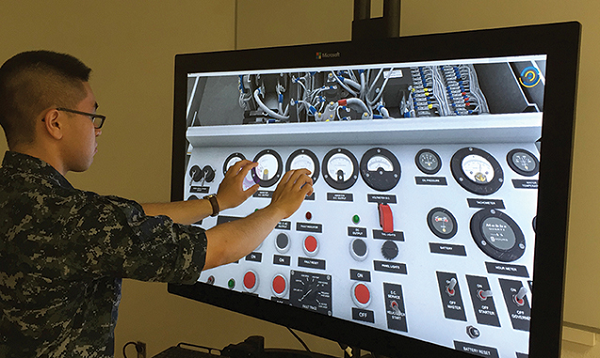
Electrician’s Mate Nuclear Power (EMN)
Length: 26 Weeks
Summary: Students in this course learn basic power distribution. They demonstrate knowledge of DC and AC motors and generators and learn to operate electrical equipment.
Electronics Technician Nuclear (ETN)
Length: 26 Weeks
Summary: Future Electronics Technicians will learn how to use solid state devices, testing equipment, digital logic and systems in addition to electricity and electronics.
Machinist’s Mate Nuclear Power (MMN)
Length: 26 Weeks
Summary: This course teaches knowledge and the operation of steam power plants. They will learn how to operate and test both equipment and systems through classroom instruction.
A Schools at Naval Chaplaincy School & Center at Fort Jackson, SC
Religious Program Specialist (RP)
Length: 8 Weeks
Summary: This course teaches Religious Program Specialists basic required skills through group-paced training.
A Schools at Sheppard Air Force Base, TX
Construction Electrician (CE)
Length: 20 Weeks
Summary: This course teaches Construction Electricians basic construction skills and theories. It also teaches basic combat skills.
Utilitiesman (UT)
Length: 13 Weeks
Summary: Individuals will learn basic construction skills surrounding installation, operation and maintenance of plumbing, wastewater and piping. They will also learn basic combat skills.
A Schools at Naval Technical Training Center Lackland, TX
Master at Arms (MA)
Length: 9 Weeks
Summary: Master at Arms learn crime prevention, first aid, military and civil law, firearms deployment and physical restraint techniques.
A Schools at Medical Education and Training Campus at Joint Base San Antonio-Fort Sam Houston, TX
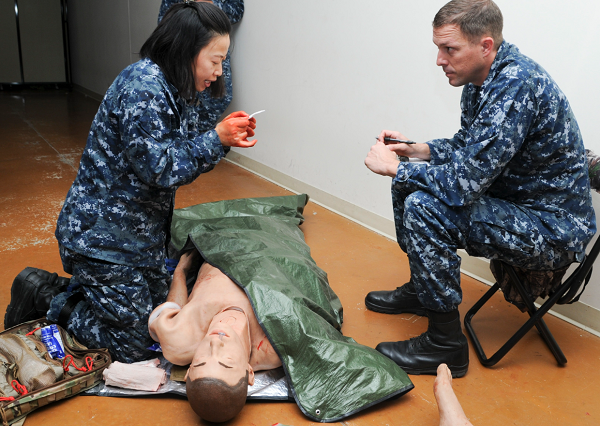
Hospital Corpsman (HM)
Length: 19 Weeks
Summary: Future Hospital Corpsman will learn basic techniques of patient care. They will also learn first aid procedures and skills related to their rating. Other career paths in the Corpsman field include Morticians and Advanced Technical Fields, such as Search and Rescue and Dive medics
A Schools at Dam Neck, Naval Air Station Oceana, VA
Intelligence Specialist (IS)
Length: 13 Weeks
Summary: Future Intelligence Specialist are taught about intelligence administration, maps and charts. They learn basic computer software skills and operational intelligence.
A Schools at USAG Fort Lee, VA
Culinary Specialist (CS)
Length: 5 Weeks
Summary: Class A Technical School for Culinary Specialists consists of learning food preparation, nutrition, and dining service.
A Schools at Joint Expeditionary Base Little Creek-Fort Story, VA
Musician (MU)
Length: 21 Weeks
Summary: Musicians study instrumental performance and fundamentals of music theory. They complete ear training and focus on various music topics. They also learn about performing in a Navy context, for ceremonial and educational outreach.
Frequently Asked Questions
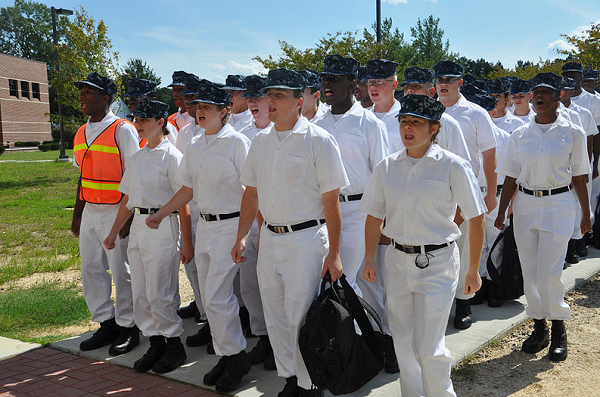
Do you get leave after A School? If so, how long?
Yes, in most cases you do get leave after A School.
According to the Naval Technical Training Center, leave is usually 14 days.
However, the Navy provides transport from your training station to your next duty station, so any travel outside of this is at your own expense.
Also, this time may be shorter, or no leave may be permitted, depending on the needs of the Navy and your new duty station.
Are you paid during A School?
Yes, you are paid during A School.
Pay is based on your standard base pay and can sometimes be slightly lower during initial training.
What happens after A School?
After A School, individuals will usually receive a short leave prior to reporting to their first duty station.
Individuals will report to their duty station to begin hands-on training, generally on a ship.
The Navy has recently changed their training structure that shortens the training sailors will receive prior to reporting to duty.
What can you bring with you to A School?
Specific items can vary based on location.
Family is not permitted at A School, but most schools allow you to bring the vast majority of personal items.
You can bring civilian clothes, as you will be permitted to wear them later in training.
Most A Schools allow you to bring items such as your cell phone and laptop. Some schools also allow you to bring your personal vehicle.
Keep in mind that you have a small space and are required to keep the area clean and neat.
Your training is usually shorter, so bring only personal items you believe you will need during your training period.
Also, keep in mind that liberty time is earned and the use of items may not be permitted initially.
Conclusion
The Navy is changing how it trains sailors, and A School is being impacted significantly.
Some A School lengths have shortened and some locations may have changed.
Your school location and training length will depend on your specific rating.
Unless you are in a PACT program, you will find out where you will attend A School when meeting with your recruiter.
A Schools can be found in several US states and military installations.
The guide above provides information on the states Navy schools are located, where each rating will receive training, the length of training, and more.
- Navy Reserve Pay for 2023 - March 20, 2022
- Navy Ranks And Basic Pay For 2023 - March 20, 2022
- Delayed Entry Program (DEP) 2023 Guide - March 20, 2022

